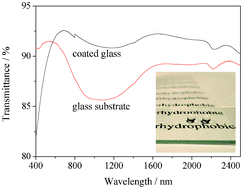Fabrication of visible/near-IR antireflective and superhydrophobic coatings from hydrophobically modified hollow silicananoparticles and poly(methyl methacrylate)†
Abstract
A facile

* Corresponding authors
a
Functional Nanomaterials Laboratory and Key Laboratory of Photochemical Conversion and Optoelectronic Materials, Technical Institute of Physics and Chemistry, Chinese Academy of Sciences, Zhongguancundonglu 29, Haidianqu, Beijing 100190, China
E-mail:
jhhe@mail.ipc.ac.cn
Fax: +86 10 82543535
b Graduate University of the Chinese Academy of Sciences, Beijing 100049, China
A facile

 Please wait while we load your content...
Something went wrong. Try again?
Please wait while we load your content...
Something went wrong. Try again?
L. Xu, L. Gao and J. He, RSC Adv., 2012, 2, 12764 DOI: 10.1039/C2RA22107A
To request permission to reproduce material from this article, please go to the Copyright Clearance Center request page.
If you are an author contributing to an RSC publication, you do not need to request permission provided correct acknowledgement is given.
If you are the author of this article, you do not need to request permission to reproduce figures and diagrams provided correct acknowledgement is given. If you want to reproduce the whole article in a third-party publication (excluding your thesis/dissertation for which permission is not required) please go to the Copyright Clearance Center request page.
Read more about how to correctly acknowledge RSC content.
 Fetching data from CrossRef.
Fetching data from CrossRef.
This may take some time to load.
Loading related content
